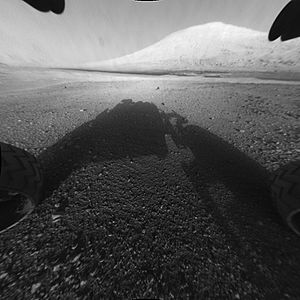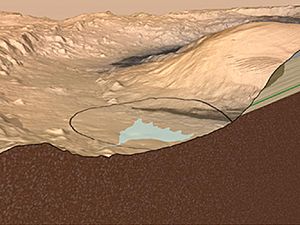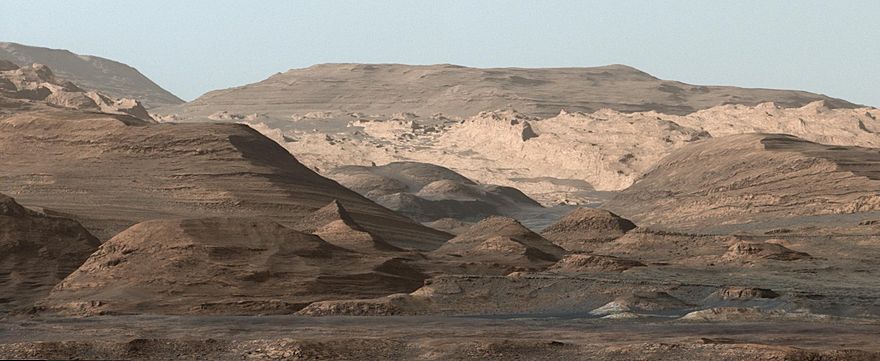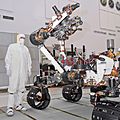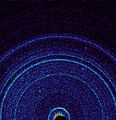Curiosity rover facts for kids
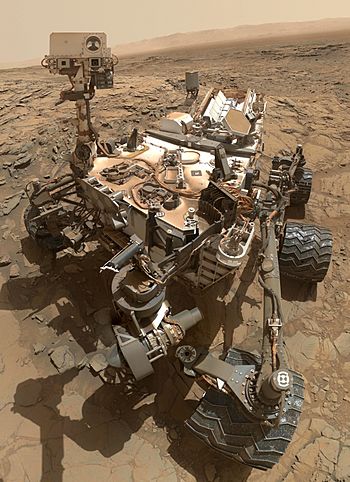
Self-portrait of Curiosity located at the foothill of Mount Sharp (October 6, 2015)
|
|
| Mission type | Mars rover |
|---|---|
| Operator | NASA |
| Mission duration | Primary: 668 sols (687 days) Current: 4522 sols (4646 days) since landing |
| Spacecraft properties | |
| Manufacturer | |
| Dry mass | Rover only: 899 kg (1,982 lb) |
| Start of mission | |
| Launch date | November 26, 2011, 15:02:00 UTC |
| Rocket | Atlas V 541 (AV-028) |
| Launch site | Cape Canaveral LC-41 |
| Orbital parameters | |
| Reference system | Heliocentric (transfer) |
| Mars rover | |
| Spacecraft component | Rover |
| Landing date | August 6, 2012, 05:17:57 UTC SCET MSD 49269 05:53:28 AMT |
| Landing site | Aeolis Palus ("Bradbury Landing") in Gale Crater (4°35′22″S 137°26′30″E / 4.5895°S 137.4417°E) |
| Distance covered | 18.13 km (11.27 mi) as of 11 February 2018[update] |
|
Mars rovers (NASA)
|
|
The Curiosity rover is a robotic car-sized Mars rover. It is exploring Gale Crater, which is near the equator of Mars. The rover uses a nuclear power and is part of NASA's Mars Science Laboratory (MSL).
The MSL mission has four main scientific goals: study Martian climate and geology, search for water, and find out whether Mars could have ever supported life. Curiosity carries the most advanced scientific equipment ever used on the surface of Mars.
Curiosity is the fourth NASA surface rover sent to Mars in 16 years. Curiosity is also the heaviest robotic wheeled vehicle (at 900 kg) to have ever landed on Mars (The Soviet Union's Lunokhod 2 lunar rover (1800) used to be the largest with 840 kg). Curiosity was launched from Cape Canaveral on November 26, 2011 at 10:02 EST. It successfully landed on Aeolis Palus in Gale Crater on Mars on August 6, 2012, 05:21:27 UTC.
In December 2012, Curiosity's two-year mission was extended indefinitely. On August 7, 2017, NASA celebrated the fifth anniversary of the Curiosity rover landing and related exploratory accomplishments on the planet Mars. The rover is still operational, and as of April 26, 2025, Curiosity has been on Mars for 4522 sols (4646 total days) since landing on August 6, 2012.
Curiosity's design served as the basis for the Mars 2020 rover to be launched in July 2020.
Contents
Goals
The main scientific goals of the MSL mission is to search whether Mars could ever have supported life or water and to study the climate and geology of Mars. The Curiosity rover has six main scientific objectives:
- Search for minerals found on the crater surface and near-surface geological materials.
- Detect signs of life
- Study the many processes that have formed and changed rocks and soils.
- Study the atmosphere of Mars
- Observe the movement and cycles of water and carbon dioxide.
- Investigate the surface radiation, including cosmic radiation, and radiation of protons and neutrons.
Landing site
The rover's landing was planned for a small region of Aeolis Palus within Gale crater. Gale crater is an about 2 billion-years-old impact crater on Mars. It was filled with sediments by water and wind. Later, wind erosion removed all sediments, leaving a 5.5 km (3.4 mile) high mountain (Mount Sharp).
The crater is 154 km (94 mi) wide. The crater was chosen because it may allow for the study of two billion years of Martian history. The landing site is also near an alluvial fan. The alluvial fan is believed to be the result of a flow of ground water.
Coverage and popular culture
NASA collected more than 1.2 million names from people who sent their names from 2009 to 2011. Their names are on a microchip which is located on the deck of Curiosity.
Live videos showing the first footage from the surface of Mars was available at NASA TV. It was shown live during the night of August 5, 2012. The NASA website became unavailable because of the large number of people visiting it.
A 13-minute NASA video of the landing, on YouTube, also became unavailable for several hours. A robotic DMCA notice was sent from Scripps Local News who prevented access. Around 1,000 people gathered in New York City's Times Square, to watch NASA's live broadcast of Curiosity's landing.
Geology
The Curiosity rover has three scoops which can dig up the soil on Mars so it can be studied. These scoops are kept clean by using Martian sand as an abrasive cleaner. Soil samples are studied inside Curiosity using a chemistry and mineralogy instrument called CheMin. CheMin uses X-ray diffraction to discover what minerals are in the soil samples. This information is then sent back to Earth.
Wide images
The name: Curiosity
A NASA panel selected the name Curiosity following a nationwide student contest that attracted more than 9,000 proposals via the Internet and mail. A sixth-grade student from Kansas, twelve-year-old Clara Ma from Sunflower Elementary School in Lenexa, Kansas, submitted the winning entry. As her prize, Ma won a trip to NASA's Jet Propulsion Laboratory (JPL) in Pasadena, California, where she signed her name directly onto the rover as it was being assembled.
Ma wrote in her winning essay:
Curiosity is an everlasting flame that burns in everyone's mind. It makes me get out of bed in the morning and wonder what surprises life will throw at me that day. Curiosity is such a powerful force. Without it, we wouldn't be who we are today. Curiosity is the passion that drives us through our everyday lives. We have become explorers and scientists with our need to ask questions and to wonder.
NASA gave the general public the opportunity from 2009 until 2011 to submit their names to be sent to Mars. More than 1.2 million people from the international community participated, and their names were etched into silicon using an electron-beam machine used for fabricating micro devices at JPL, and this plaque is now installed on the deck of Curiosity.
In keeping with a 40-year tradition, a plaque with the signatures of President Barack Obama and Vice President Joe Biden was also installed. Elsewhere on the rover is the autograph of Clara Ma, the 12-year-old girl from Kansas who gave Curiosity its name in an essay contest, writing in part that "curiosity is the passion that drives us through our everyday lives."
On August 6, 2013, Curiosity audibly played "Happy Birthday to You" in honor of the one Earth year mark of its Martian landing, the first time for a song to be played on another planet. This was also the first time music was transmitted between two planets.
Images for kids
-
Two Jet Propulsion Laboratory engineers stand with three vehicles, providing a size comparison of three generations of Mars rovers. Front and center left is the flight spare for the first Mars rover, Sojourner, which landed on Mars in 1997 as part of the Mars Pathfinder Project. On the left is a Mars Exploration Rover (MER) test vehicle that is a working sibling to Spirit and Opportunity, which landed on Mars in 2004. On the right is a test rover for the Mars Science Laboratory, which landed as Curiosity on Mars in 2012. Sojourner is 65 cm (26 in) long. The Mars Exploration Rovers (MER) are 1.6 m (5 ft 3 in) long. Curiosity on the right is 3 m (9.8 ft) long.
-
Curiosity and surrounding area as viewed by MRO/HiRISE. North is left. (14 August 2012; enhanced colors)
-
First laser spectrum of chemical elements from ChemCam on Curiosity ("Coronation" rock, 19 August 2012)
-
First X-ray diffraction view of Martian soil (Curiosity at Rocknest, 17 October 2012)
See also
 In Spanish: Curiosity para niños
In Spanish: Curiosity para niños


